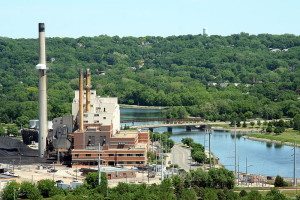EPA regs threaten to close coal-fired power plants, but states push back

By Eric Boehm | Watchdog.org
For 60 years, the power plant on the outskirts of the tiny Missouri hamlet of Chamois turned mountains of coal into cheap electricity.
Last year, the plant closed its doors.
“It’s just really kind of sad, honestly. It’s just one more thing that means fewer jobs for people out here,” said Diane Martellaro, who co-owns a marble and granite business in Chamois, a tiny dot on the map with a population of about 400 along the banks of the Missouri River, about halfway between St. Louis and Jefferson City.
COAL NO MORE: New EPA regulations might force existing coal power plants, like the Silver Lake Power Plant in Rochester, MN, to shut down.
The town’s population has since declined, she said.
The Union Pacific train line that used to supply the plant with coal no longer runs through town, and the local school will probably have to close soon because the power plant provided most of the necessary tax revenue to keep it running.
Changing market forces — such as the growth in natural gas supplies for other power plants — factored in the decision. But the cost associated with updating the older facility to meet future regulations on emissions from coal power plants was the “major factor” behind the closure, said the company that owned the plant.
Central Electric Power Cooperative believed it would cost $14 million or more to meet the new emissions standards being crafted by the Environmental Protection Agency, according to a statement announcing the closure.
Monday, the EPA officially unveiled those new regulations. The scenario in Chamois might soon be playing out over and over again across the Midwest, home to most of the states with the highest dependency on coal-fired power plants.
The new regulations aim to cut power plants’ carbon emissions by 30 percent by 2030, with specific targets for each state.
The federal government is pitching the new policy as a way to unify the efforts of some local areas and promising that better emissions standards will improve public health and the environment.
But the economic consequences of forcing coal-fired power plants offline will stretch far beyond the immediate effects in Chamois.
For Missouri, a state that gets 82 percent of its electricity from coal power plants, the regulations could be particularly onerous — costing not only jobs for the workers at soon-to-be closed plants but higher costs for businesses that will no longer have access to the cheap power from the coal-fired plants.
Missouri is one of a handful of states already working to undermine some of the EPA’s regulatory power before the new rules were announced Monday.
A bill passed last month by the Missouri General Assembly would give the state’s Air Conservation Commission the ability to develop state-level emissions standards in place of the new federal rules. Unlike the new standards being pushed by the EPA, the state agency would be required to take into account job losses and economic consequences such as higher energy bills.
The bill got bipartisan support in both chambers of the state Legislature and is awaiting a signature from Gov. Jay Nixon, a Democrat.
“The actions of the Obama administration make it clear that they intend to wipe out coal as an energy source. This would be a misguided and costly action that would leave Missouri’s business and individual energy consumers on the hook for massive rate increases,” said Daniel Mehan, president and CEO of the Missouri Chamber of Commerce, which supported the bill.
Missouri isn’t alone. Neighboring Kansas, which relies on coal for 63 percent of its electricity, has approved similar legislation.
“What we’re saying is, Let us handle greenhouse gas emissions. We think we can do it more effectively than you can at the federal level, and we want to look at all factors, including economic,” Gov. Sam Brownback said when he signed the bill into law in April.
It’s the age-old battle between states and the federal government for control of important policy.
The EPA seems willing to give states a seat at the table in the new rule-making process. The rules issued Monday would allow each state to make its own plan to meet federally determined carbon emission standards. The states will have one year to make a plan and get it approved by the federal agency, which will then monitor their progress.
In Chamois, that battle has already been decided, yet hundreds of other coal-fired power plants across the Midwest will hang in the balance.
Boehm can be reached at EBoehm@Watchdog.org. Follow @WatchdogOrg on Twitter for more.







